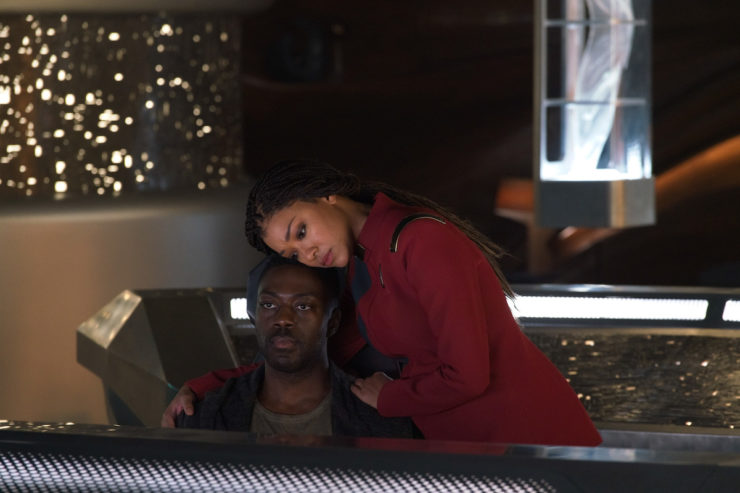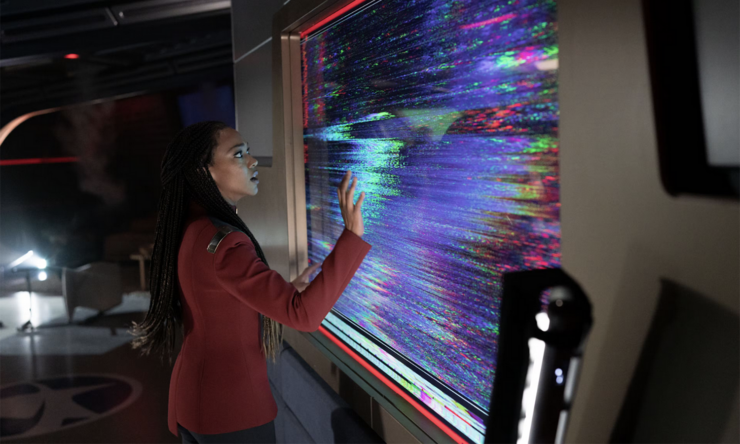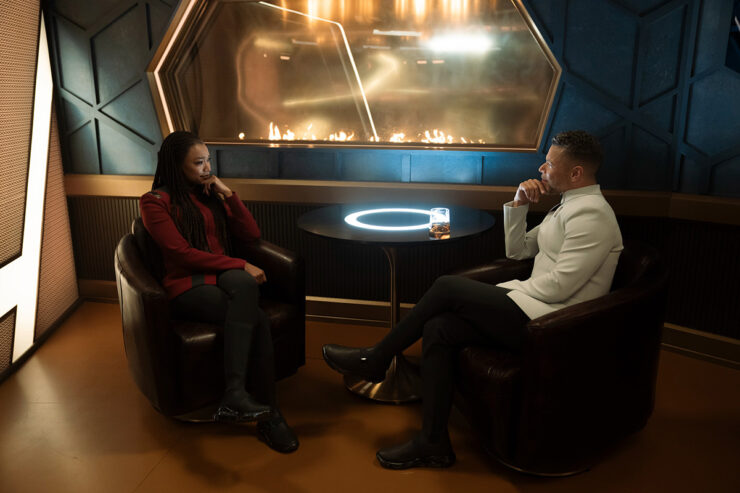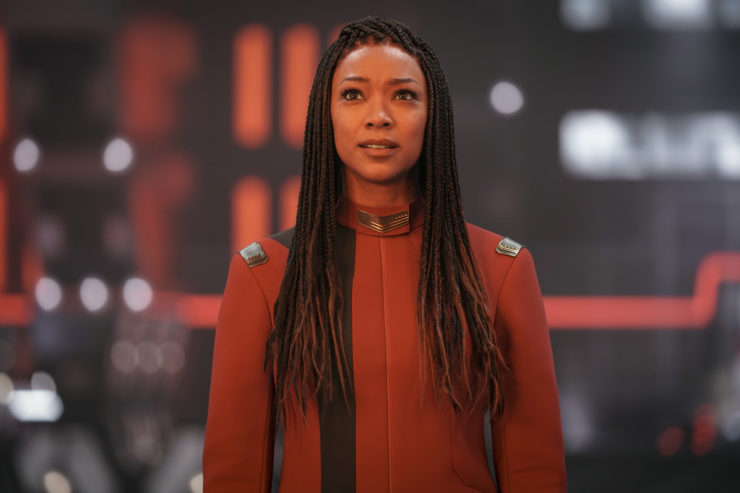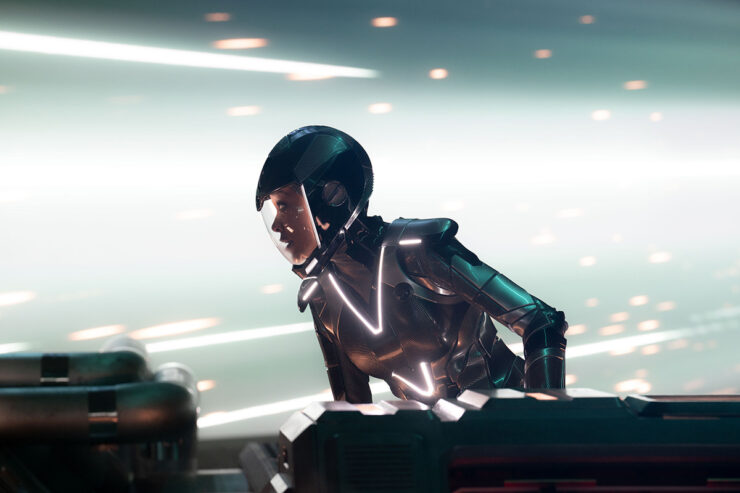The current crop of Star Trek shows seem to have settled on a ten-episode season. Picard, Lower Decks, and Strange New Worlds are all doing ten-episode seasons, and while technically Prodigy’s first season is twenty, those first ten form a nice discrete unit.
The exception, of course, has been the flagship show of this current wave of Trek shows, and the fourth season of Discovery has given us a baker’s dozen of episodes that might have been better off as half a score…
For most of this season, the pacing was excellent, right up to “…But to Connect,” which served as a pausing point, as Paramount+ took a hiatus from releasing new Discovery episodes in favor of five weeks’ worth of Prodigy. “…But to Connect” ended with a sense of urgency, as Discovery is racing against Book’s ship to reach Species 10C outside the galaxy. But then we got two or three episodes’ worth of story jam-packed into (checks notes) six episodes. Yeah.
That sense of urgency was utterly squandered in the back half of the season, spending an entire episode on a trip to Space Vegas, another entire episode on the trip through the galactic barrier (a trip that took less than five minutes the other three times we saw ships do it), and the events of the final two episodes didn’t really need to take up two entire episodes.
Overall, the season has cemented what the third season already showed: Discovery is significantly more interesting in the thirty-second century. In the aftermath of reversing the Burn last season and in the uniting of folks to deal with the DMA this season, we’ve seen the slow rebuild of the Federation, and a reminder of what Star Trek’s optimistic future has always been about: cooperation, compassion, and conversation.
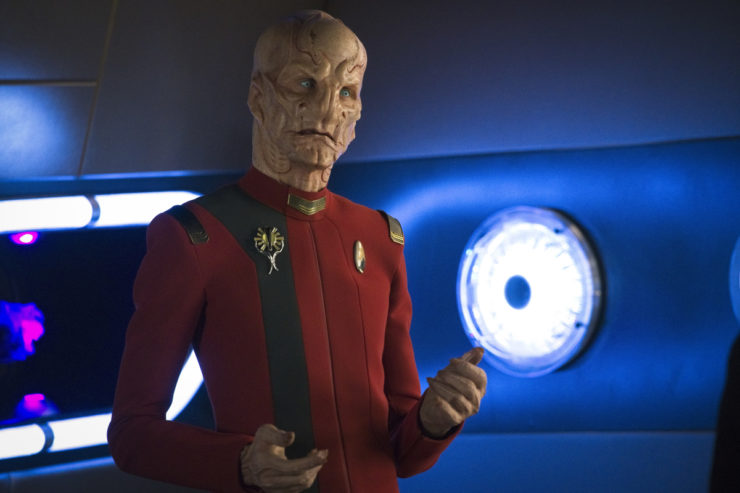
In particular, I like that this season they don’t feel the need to graft an action-adventure storyline into the climax of the seasonal arc to make it more exciting. Because honestly? No amount of fights against Klingons, no number of space battles against Control’s ships, no number of Die Hard sequences on board Discovery can match the sheer joy and glory of watching Burnham, Rillak, Saru, Hirai, and Book talking to Species 10C, of watching two disparate peoples find a common ground, find a way to communicate, and find a way to solve the problem they all face.
Buy the Book


A Prayer for the Crown-Shy
As I said in my review of “Species Ten-C,” one of the most common complaints I’ve seen about Discovery is that the producers don’t understand Star Trek. Of course, that complaint has been leveled against every single new production of the franchise over the decades, starting with The Wrath of Khan in 1982. Forty years ago, it was Gene Roddenberry his own self going to conventions and urging fans not to support the second movie because Nicholas Meyer didn’t understand his vision (nothing changes…). The complaint that this new version of Trek isn’t “real Trek” has been made against TNG, DS9, Voyager, Enterprise, the Bad Robot movies, and the current crop of shows, and having heard it for four decades, I have a hard time taking it seriously.
I especially have a hard time taking it seriously after watching a season of Discovery that is, philosophically, as pure a season of Star Trek as has ever been produced in fifty-plus years. (Please note that this doesn’t mean that it’s the best, merely that, as a whole, it is most true to the spirit of what has made Trek unique lo these many years.) It started with Burnham and Book trying to help a species that had been isolated since the Burn, offering them some of the new dilithium they’d mined, and continuing to work to help them even after they started shooting. We have the tragedy of the Dark Matter Anomaly, which destroys Book’s homeworld (thus giving us stakes) and then we follow the efforts of numerous scientists (including Stamets) trying to figure the fershlugginer thing out, in true Trek fashion. We get Ni’Var rejoining the Federation. We get a magnificent discussion across dozens of species about how to deal with the DMA and their creators, in which the notion of going into battle is considered the bad option.
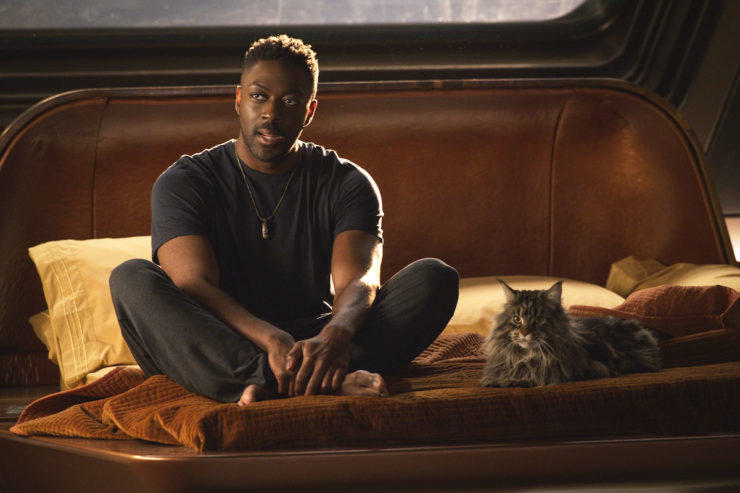
The first half of the season was especially strong, giving us a bunch of really good standalone episodes that still moved the overall story forward. Gray gets a body and gets to go back to Trill to be a guardian. Culber grows into his role as ship’s counselor. Book has to deal with losing his entire world. Saru finds his place on the ship he used to command after deciding to once again leave the safety of Kaminar for Starfleet. Tilly grows up a great deal and finds new purpose as a teacher at the Academy (the Tilly of the season finale who faced death calmly is so much more mature than the motormouth we met in “Context is For Kings,” and the progression is completely believable and logical and magnificently played by Mary Wiseman). The superb chemistry between Saru and T’Rina from last season is developed nicely, and Doug Jones and Tara Rosling are simply magnificent together. We see more of the Qowat Milat (one of the best things to come out of Picard) and Gabrielle Burnham, Admiral Vance is still a major supporting character (and Oded Fehr remains spectacular in the role—his symphony analogy in “Choose to Live” was a particular high point), and we get a fabulous new one in President Laira Rillak.
My favorite thing this whole season is watching the developing relationship between Burnham and Rillak, very nicely played by Sonequa Martin-Green and Chelah Horsdal. The captain and the president start out somewhat adversarial, but the more they work together the more smoothly their working relationship becomes, and by the time the season is over, the pair of them make a fantastic team talking to 10C and convincing them to retract the DMA and stop causing harm to these individual life forms that they didn’t even recognize as being higher life forms until they showed up on their doorstep.
Star Trek has always, at its heart, been about hope for the future. The presence of Uhura, Sulu, and Chekov on the bridge of the Enterprise gave the 1966 audience hope of a united Earth during a time when such a notion seemed like a ridiculous fantasy. Trek has always aspired to show us that the world can be a better place than it is now, but there’s always been room for improvement. Until 2017, there was no acknowledgment of non-heterosexuals in the future, for example. And in 2022, it’s wonderful to see so many of the main characters are women, and the fact that they’re mostly women is not an issue one way or the other (I’m looking at you “Turnabout Intruder” and “The Lorelei Signal“…). And they’re many different types of women, different ages, different skin tones, different body types, and none of them are sexualized.
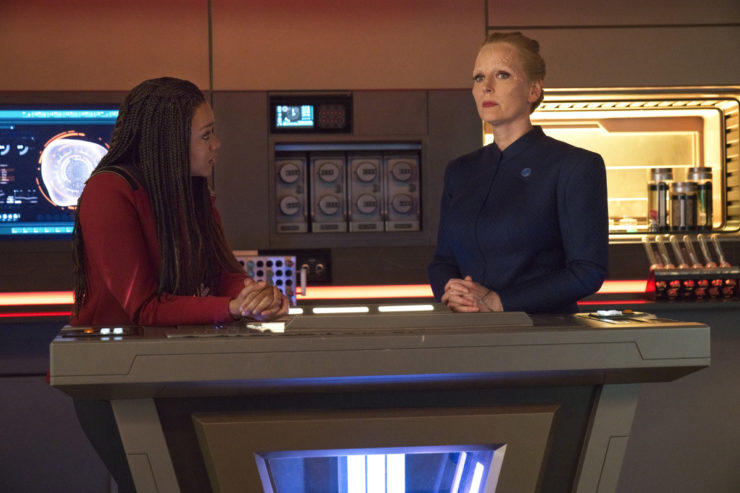
It might have worked better as ten episodes like all the other Paramount+ shows have settled on, but it’s still a strong season of a show that continues to improve, and which continues to move the Trek universe forward in so many ways. And it’s very much not perfect. Besides the various pacing issues, there’s also the bizarre dichotomy that the show perfectly understands the love of science and the joy of discovery (pun intended) that the characters all have—and yet the actual science in most episodes is laughably bad, even by Trek’s hit-and-miss standards of same.
Still, I’m looking forward to next season and seeing how they continue to rebuild the Federation. Also hoping we continue to see more of Rillak and Vance and Kovich, and we get more fleshing out of the bridge crew, and just in general, I want more of what we’ve had. Maybe with a bit less bad science, and just maybe a bit lower stakes this time?
Keith R.A. DeCandido will be an author guest at HELIOsphere 2022 this coming weekend. He’ll be doing panels and programs and things, and also spending time at eSpec Books’s booth in the dealer room. Click here for his schedule.










